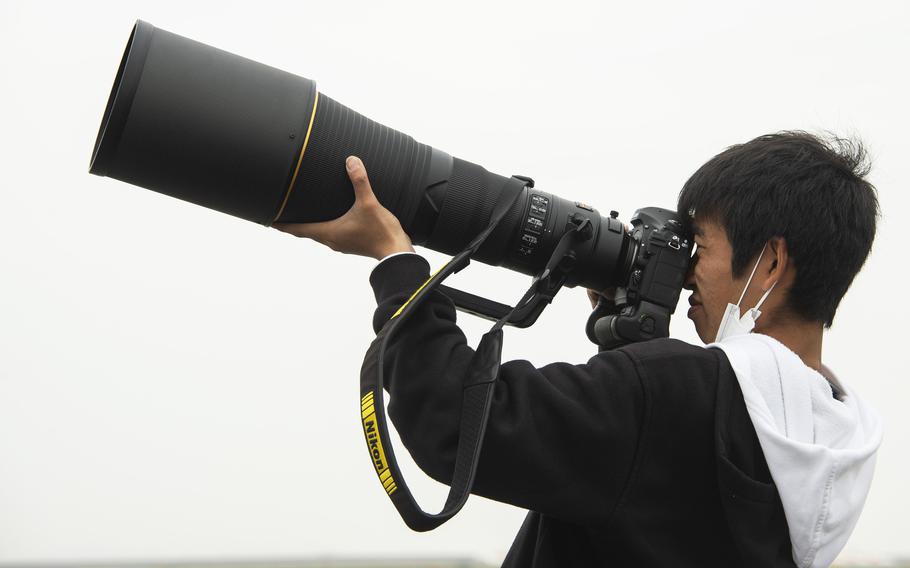Asia-Pacific
Marine base in Japan is plum location for military aircraft tail spotters
Stars and Stripes May 12, 2023

Masafumi Mizuoka, a college student from Osaka, photographs aircraft taking off from Marine Corps Air Station Iwakuni, Japan, April 19, 2023. (Jonathan Snyder/Stars and Stripes)
MARINE CORPS AIR STATION IWAKUNI, Japan — This busy base south of Hiroshima attracts tail spotters from around the world who come to photograph American fighter jets and Japanese search-and-rescue aircraft from just beyond the runway.
Hans Van Der Luit, a retired lawyer from Kleipettenlaan, Netherlands, has been traveling to military bases around Japan to photograph military aircraft that aren’t common in his home country.
“These planes are very rare in the Netherlands; you don’t see that much F/A-18s,” he told Stars and Stripes just outside the fence at MCAS Iwakuni on April 11. “I see the Hawkeye, Greyhound, Poseidon, but you won’t see them in the Netherlands or in Belgium.”
Carrier Air Wing 5 has squadrons of F/A-18 Super Hornets, E-2 Hawkeyes and C-2 Greyhounds based at MCAS Iwakuni unless they’re at sea aboard the aircraft carrier USS Ronald Reagan, homeported at Yokosuka Naval Base south of Tokyo.
The Marine squadrons at Iwakuni fly F-35B Lightning II stealth fighters and KC-130J refuelers. Japan’s Fleet Air Wing 31 operates its ShinMaywa US-2, P-3 Orion and Learjet Model 36 from the shared air station.
In between photographing military aircraft taking off and landing, Luit pulled out a small notebook while reviewing his freshly taken images, comparing the tail numbers to those in his notebook.
“A lot of people have this hobby because they want to collect the numbers, each individual plane they want to have,” he said. “I can be very happy when I see a plane I don’t have.”
The Japan Maritime Self-Defense Forces has no issue with tail spotters taking photographs outside the fence at the Self-Defense Forces area of MCAS Iwakuni, said Lt. Cmdr. Tetsuya Morinaga, spokesman for Fleet Air Wing 31, on April 25.
As long as tail spotters take photos for their own pleasure, the Self-Defense Force is not concerned, he said. However, it could become a problem if they come every day to take photos and record data that reveals military operations.
The U.S. Marine Corps also tolerates tail spotters.
“We are aware that the air station draws the attention of many aviation enthusiasts,” base spokesman 1st Lt. Aaron Ellis told Stars and Stripes by email on April 28.
He declined to discuss specific measures security forces takes to protect the aircraft or if they monitor tail spotters. On any given day, up to several dozen photographers can be seen along a narrow access road near the runway.
“What we can say is that we take security seriously and we have a robust posture that ensures the safety and security of the air station and its tenant units,” Ellis said.
The U.S. military sometimes connects with aviation enthusiasts at its bases and offers base tours and up-close aircraft opportunities.
“I say to people of the American forces that think we are spies, it’s only personal,” Luit said. “We are not interested in buildings; we only want to take photos of the planes.”
Masafumi Mizuoka, a college student from Osaka, made his first trip to MCAS Iwakuni on April 19 to photograph military aircraft, he said on April 11.
He’s a regular at Komatsu Air Base, a Japan Air Self-Defense Force installation in Ishikawa prefecture. He said he visits bases up to 80 days a year and mainly takes photos of fighter jets.
Mizuoka started tail spotting in junior high. His father, a photographer for an aircraft magazine, got him interested in the hobby by taking Mizuoka with him on assignments.
Mizuoka said he’s wanted to visit MCAS Iwakuni ever since he saw “Top Gun: Maverick,” which he watched several times. He said he was surprised by the number of aircraft that fly from the air station.
"It evokes collectors' desire to take photos of unusual aircraft, or aircraft with unusual paint jobs," he said.